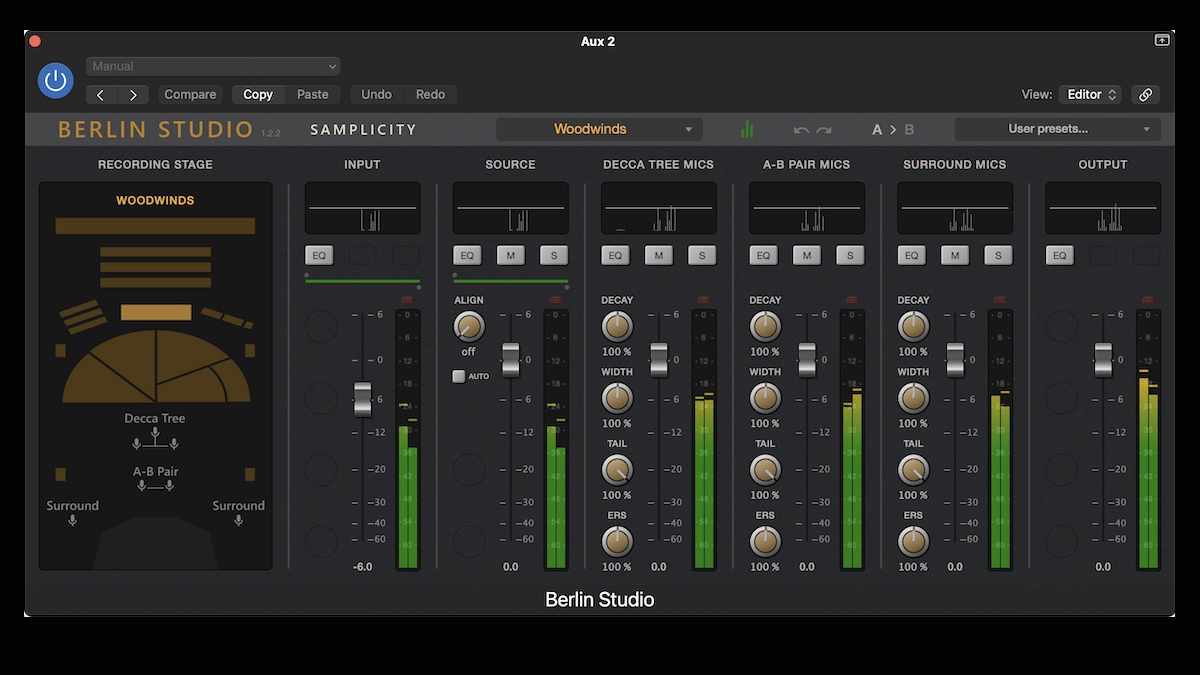Effects
Samplicity Berlin Studio Reverb – the Synth and Software Review

Teldex Studio in Berlin is sampled: put your large ensembles in a cohesive space
Think of Samplicity Berlin Studio as a whole herd of well-trained one-trick ponies.
Better yet, don’t think of ponies, but rather the trick: it’s a large recording stage convolution reverb (Teldex Studio in Berlin), designed for use with orchestral instruments. The herd in this ridiculous analogy is that it uses many convolution samples to position all the instruments in that studio in two dimensions, and it provides a lot of options.
Of course, there’s nothing to say that you can only use it for orchestral instruments, because it’s ultimately just a very nice large room reverb (or several of them in one). But anyone who’s ever tried to create a realistic orchestral soundstage knows that depth placement especially can be a challenge. Then when you combine instruments from different orchestral libraries, as we all do, there are still more variables to contend with – including putting them in the same space.
Now, I don’t want to say that Berlin Studio makes getting a good orchestral space trivial, because that’s not possible. But it certainly helps having preset positions for each section – violins 1, violins 2, winds, etc. in the whole soundstage, not just left and right.
With traditional reverbs, both algorithmic and convolution, it’s very small spaces that separate the boys and girls from the men and women. That doesn’t apply when the ponies’ trick is putting instruments in a large orchestral room.
So let’s go straight to my second test: flute (or similar). You can hear right away whether a reverb sticks to the instruments, and whether it sounds plastic or organic.
Rather than trying to translate those adjectives, check out this example of solo flute 1 from EastWest’s Opus Orchestra. I turned off the reverb in the Opus player and the early reflections in Berlin Studio, and also just used the flute’s close mics (it’s sampled from multiple positions):
You can hear other examples on the Samplicity website.
Berlin Studio’s interface is a mixer with three different mic positions, rather than the typical screen with parameters on standard reverbs. Those mic positions are Decca tree, then A/B farther back, and then Surround even farther back.
As you can see, there’s EQ on each channel. That’s a great feature, because – maybe with orchestral instruments even more than anything else – you can easily lose hours trying in vain to get a mix to work, when the problem is with the reverb(s) and not the instruments themselves.
Berlin Studio doesn’t come with (or really need) any documentation, but it turns out that the EQ is pre-reverb. However, the developer points out that post-reverb EQ would be mathematically the same, since this is a convolution processor.
So you’ll probably want to put EQ on at least some instruments before they reach the reverb. For example, concert bass drums generally want to have their rumble (below around 80Hz) removed from the reverb send, because it tends to muddy the reverb sound itself. The same can apply to funny resonances in other instruments.
Unless you use it inline on only one DAW channel, a lot of the time you’ll want Berlin Studio on a send so that more than one instrument can share the same instance. One exception might be if you’re using an orchestral library with reverb tail that’s separated from its predelay.
So you’d use the early components of the sound (i.e. the embedded predelay) from the sample library, which tell the ear about the space, and then you share one or two large reverb tails. Berlin Studio’s separate, adjustable impulse recordings of the predelay are an excellent feature.
The mixer interface makes a lot of sense in this context. Maybe the ability to group the three mic position faders would be useful – a first-world problem – but you can save presets.
As an aside, Apple Logic Pro gets unhappy if you try to insert Berlin Studio before inserting an instrument the plug-in. Also, Berlin Studio may require a larger buffer setting than you’re used to using – 256 samples in my case, but that’s because it’s set up to have very low latency.
One thing you may find surprising is that Berlin Studio’s horizontal positioning is pretty subtle. You can supplement that with the pan control on your DAW’s mixer, but if you choose, say, the Violins 1 (to the left of the conductor) the sound comes mainly from the middle.
Why? Because of where the three mic positions are sampled. You can narrow the stereo width for a somewhat more pronounced positioning effect, but it’s mainly the nature of this kind of recording: placing stereo mics from some distance doesn’t give you an exaggerated panning effect, simply because of the geometry.
Also, orchestras are a blend of instruments, and these miking techniques support that. You’ll want to treat solos separately from the ensemble, maybe simulating spot mics. If you use Berlin Studio for solos, you might want to use more of the closer Decca tree mics for a little more narrow positioning.
Thus: If you’re looking for a bombasic reverb with an over-the-top tail, look elsewhere. But for those of us who combine orchestral sample libraries, Berlin Studio is simply a very nice large scoring stage reverb that does one thing really well.
Price: € 169.00
















